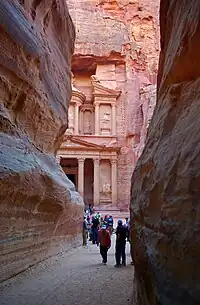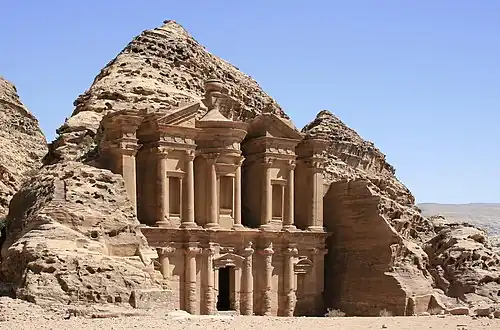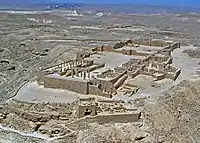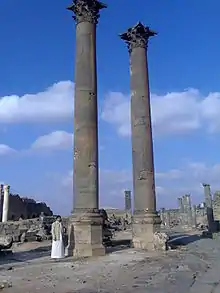Nabataeans
The Nabataeans or Nabateans (/ˌnæbəˈtiːənz/; Nabataean Aramaic: 𐢕𐢃𐢋𐢈, NBṬW, vocalized as Nabāṭū; Arabic: ٱلْأَنْبَاط, al-ʾAnbāṭ, singular النبطي, an-Nabaṭī; compare Ancient Greek: Ναβαταῖος, romanized: Nabataîos; Latin: Nabataeus) were an ancient Arab people who inhabited northern Arabia and the southern Levant.[1][2][3][4][5][6][7] Their settlements—most prominently the assumed capital city of Raqmu (present-day Petra, Jordan)[1]—gave the name Nabatene (Ancient Greek: Ναβατηνή, romanized: Nabatēnḗ) to the Arabian borderland that stretched from the Euphrates to the Red Sea.
 A map of the Roman empire under Hadrian (ruled CE 117–138), showing the location of the Arabes Nabataei in the desert regions around the Roman province of Arabia Petraea | |
| Languages | |
|---|---|
| |
| Religion | |
| Related ethnic groups | |
| Arabs |
The Nabateans emerged as a distinct civilization and political entity between the 4th and 2nd centuries BCE,[8] with their kingdom centered around a loosely controlled trading network that brought considerable wealth and influence across the ancient world.
Described as fiercely independent by contemporary Greco-Roman accounts, the Nabataeans were annexed into the Roman Empire by Emperor Trajan in 106 CE. Nabataeans' individual culture, easily identified by their characteristic finely potted painted ceramics, was adopted into the larger Greco-Roman culture. They converted to Christianity during the Later Roman Era. Jane Taylor describes them as "one of the most gifted peoples of the ancient world".[9][10]
Name
The original form of the name of the Nabataeans was Nabaʾatu, which is recorded in Babylonian Akkadian as Nebaʾati, and was the "broken" plural faʿalatun form nabī of the Arabic term nabīʾu, meaning "distinguished man." This name Nabaʾatu underwent two principal evolutions, with the omission of the hamzah glottal stop producing the form Nabāṭu, and the replacement of hamzah by a yāʾ voiced palatal approximant producing the form Nabayatu.[11]
The name of the Nabataeans is recorded in Akkadian sources as Nebaʾati, Nabayate, Nabayati, Nabaitiya, Nabaitaya, Nabatua, and Nabayati.[12]
In Latin sources, the name of the Nabataeans was recorded as Nabataei.[12]
Identity
The Nabataeans were an Arab tribe who had come under significant Babylonian-Aramaean influence.[11]
Some scholars have identified the people named as Nabayataya in Neo-Assyrian Akkadian records and Nəḇāyōṯ in the Hebrew Bible based on the similarity of their names with Nabāṭu, which is the Arabic name of the Nabataeans.[12] The scholar Israel Ephʿal has rejected this identification because of the use of a taw in the Akkadian and Hebrew forms while the Arabic form uses a ṭet, and because the former forms possess a yod which is absent from the Arabic form, as attested by to the discovery of a Taymanitic inscription in the Jabal Ġunaym which records the name of the Nabayataya as NBYT.[12] The scholar Edward Lipiński has however refuted this rejection by demonstrating that these various forms of the name were derived from an original form Nabaʾatu, from which the glottal stop was replaced by a palatal approximant, hence producing the Akkadian and Hebrew forms Nabayataya and Nəḇāyōṯ, while omission of the glottal stop produced the Arabic form Nabāṭu.[11]
History
Hellenistic period
The first mention of the Nabataeans dates from 312/311 BCE, when they were attacked at Sela or perhaps at Petra without success by Antigonus I's officer Athenaeus in the course of the Third War of the Diadochi; at that time Hieronymus of Cardia, a Seleucid officer, mentioned the Nabataeans in a battle report. About 50 BCE, the Greek historian Diodorus Siculus cited Hieronymus in his report, and added the following: "Just as the Seleucids had tried to subdue them, so the Romans made several attempts to get their hands on that lucrative trade."
They wrote a letter to Antigonus in Syriac letters, and Aramaic continued as the language of their coins and inscriptions when the tribe grew into a kingdom and profited by the decay of the Seleucids to extend its borders northward over the more fertile country east of the Jordan river. They occupied Hauran, and in about 85 BCE their king Aretas III became lord of Damascus and Coele-Syria.
Nabataean Kingdom
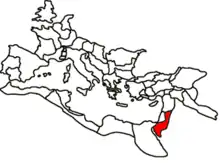
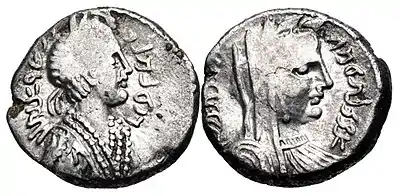

Petra was rapidly built in the 1st century BCE, and developed a population estimated at 20,000.[13]
The Nabataeans were allies of the first Hasmoneans in their struggles against the Seleucid monarchs. They then became rivals of the Judaean dynasty, and a chief element in the disorders that invited Pompey's intervention in Judea. According to popular historian Paul Johnson, many Nabataeans were forcefully converted to Judaism by Hasmonean king Alexander Jannaeus.[14] It was this king who, after putting down a local rebellion, invaded and occupied the Nabataean towns of Moab and Gilead and imposed a tribute of an unknown amount. Obodas I knew that Alexander would attack, so was able to ambush Alexander's forces near Gaulane destroying the Judean army (90 BCE).[15]
The Roman military was not very successful in their campaigns against the Nabataeans. In 62 BCE, Marcus Aemilius Scaurus accepted a bribe of 300 talents to lift the siege of Petra, partly because of the difficult terrain and the fact that he had run out of supplies. Hyrcanus II, who was a friend of Aretas, was despatched by Scaurus to the King to buy peace. In so obtaining peace, King Aretas retained all his possessions, including Damascus, and became a Roman vassal.[16]
In 32 BCE, during King Malichus II's reign, Herod the Great, with the support of Cleopatra, started a war against Nabataea. The war began with Herod plundering Nabataea with a large cavalry force, and occupying Dium. After this defeat, the Nabataean forces regrouped near Canatha in Syria, but were attacked and routed. Cleopatra's general, Athenion, sent Canathans to the aid of the Nabataeans, and this force crushed Herod's army, which then fled to Ormiza. One year later, Herod's army overran Nabataea.[17]
After an earthquake in Judaea, the Nabateans rebelled and invaded Judea, but Herod at once crossed the Jordan river to Philadelphia (modern Amman) and both sides set up camp. The Nabataeans under Elthemus refused to give battle, so Herod forced the issue when he attacked their camp. A confused mass of Nabataeans gave battle but were defeated. Once they had retreated to their defences, Herod laid siege to the camp and over time some of the defenders surrendered. The remaining Nabataean forces offered 500 talents for peace, but this was rejected. Lacking water, the Nabataeans were forced out of their camp and battled but were defeated.[18]
Roman period
An ally of the Roman Empire, the Nabataean kingdom flourished throughout the 1st century. Its power extended far into Arabia along the Red Sea to Yemen, and Petra was a cosmopolitan marketplace, though its commerce was diminished by the rise of the Eastern trade-route from Myos Hormos to Coptos on the Nile. Under the Pax Romana, the Nabataeans lost their warlike and nomadic habits and became a sober, acquisitive, orderly people, wholly intent on trade and agriculture. The kingdom was a bulwark between Rome and the wild hordes of the desert except in the time of Trajan, who reduced Petra and converted the Nabataean client state into the Roman province of Arabia Petraea.[19]
By the 3rd century, the Nabataeans had stopped writing in Aramaic and begun writing in Greek instead. By the 5th century they had converted to Christianity.[20] The new Arab invaders, who soon pressed forward into their seats, found the remnants of the Nabataeans transformed into peasants. Their lands were divided between the new Qahtanite Arab tribal kingdoms of the Byzantine vassals, the Ghassanid Arabs, and the Himyarite vassals, the Kingdom of Kinda in North Arabia. The city of Petra was brought to the attention of Westerners by the Swiss explorer Johann Ludwig Burckhardt in 1812.
Legacy
The Nabataeans are mentioned under the name of Nəḇāyōṯ in the Hebrew Bible, where they are often grouped with Qēḏār. The Roman author Pliny the Elder also listed the Nabataeans under the name of Nabataei along with the Cedrei (Qedarites) in his Naturalis Historia.[12]
Biblical

The Nabateans appear in the Hebrew Bible as a tribe descended from Nəḇāyōṯ, the first son of Yīšmāʿēʾl, himself the son of ʾAḇrāhām and Hāgār,[21][22] In the Bible, Yīšmāʿēʾl's eldest son Nəḇāyōṯ is given prominence due to the rule of primogeniture, with Yīšmāʿēʾl's second son Qēḏār also being given some level of prominence due to being the second-born son, making him the closest of Yīšmāʿēʾl's sons to the one standing for primogeniture.[23][24]
Islamic
The tradition of claiming descent from Ibrāhīm's son ʾIsmāʿīl, called "genealogical Ishmaelism," was already present among some pre-Islamic Arabs, and, in Islamic sources, ʾIsmāʿīl is the eponymous ancestor of some of the Arab peoples of north-west Arabia, with prominence being accorded to his two eldest sons, Nābit (نابت) or Nabīt (نبيت) (Biblical Nəḇāyōṯ) and Qaydar (قيدر) or Qaydār ((قيدار; Biblical Qēḏār), who lived in eastern Transjordan, Sinai and the Ḥijāz, and whose descendant tribes were the most prominent ones among the twelve tribes of the Ishmaelites.[23]
According to Islamic tradition, the Islamic prophet Muhammad is believed to have been a descendant of ʾIsmāʿīl through either Nābit or Qaydār depending on the scholar.[25]
According to the scholar Irfan Shahîd, genealogical Ishmaelism was academically viewed with suspicion due to confusion in the Islamic period which led to ʾIsmāʿīl being considered as the ancestor of all Arabian tribes. According to Shahîd, genealogical Ishamelism in its original variant is instead more limited and applicable to only some Arab tribes.[23]
Culture

Many examples of graffiti and inscriptions—largely of names and greetings—document the area of Nabataean culture, which extended as far north as the north end of the Dead Sea, and testify to widespread literacy; but except for a few letters[26] no Nabataean literature has survived, nor was any noted in antiquity.[27][28][29] Onomastic analysis has suggested[30] that Nabataean culture may have had multiple influences. Classical references to the Nabataeans begin with Diodorus Siculus. They suggest that the Nabataeans' trade routes and the origins of their goods were regarded as trade secrets, and disguised in tales that should have strained outsiders' credulity.[31]
Diodorus Siculus (book II) described them as a strong tribe of some 10,000 warriors, preeminent among the nomads of Arabia, eschewing agriculture, fixed houses, and the use of wine, but adding to pastoral pursuits a profitable trade with the seaports in frankincense, myrrh and spices from Arabia Felix (today's Yemen), as well as a trade with Egypt in bitumen from the Dead Sea. Their arid country was their best safeguard, for the bottle-shaped cisterns for rain-water which they excavated in the rocky or clay-rich soil were carefully concealed from invaders.[32]
Ibn Sayyar al-Warraq's Kitab al-Tabikh, the earliest known Arabic cookbook, contains a recipe for fermented Nabatean water bread (khubz al-ma al-nabati). The yeast-leavened bread is made with a high quality wheat flour called samidh that is finely milled and free of bran and is baked in a tandoor.[33]
Language
Historians such as Irfan Shahîd,[34] Warwick Ball,[35] Robert G. Hoyland,[36] Michael C. A. Macdonald,[37] and others[38] believe Nabataeans spoke Arabic as their native language. John F. Healy states that "Nabataeans normally spoke a form of Arabic, while, like the Persians etc., they used Aramaic for formal purposes and especially for inscriptions."[39] Proper names on their inscriptions suggest that they were ethnically Arabs who had come under Aramaic influence, and the Nabataeans had already some trace of Aramaic culture when they first appear in history. Some of the authors of Safaitic inscriptions identified themselves as Nabataeans.[40]
Religion
.jpg.webp)
The extent of Nabataean trade resulted in cross-cultural influences that reached as far as the Red Sea coast of southern Arabia. The gods worshiped at Petra were notably Dushara and Al-‘Uzzá. Dushara was the supreme deity of the Nabataean Arabs, and was the official god of the Nabataean Kingdom who enjoyed special royal patronage.[41] His official position is reflected in multiple inscriptions that render him as "The god of our lord" (The King).[42]
The name Dushara is from the Arabic "Dhu ash-Shara": which simply means "the one of Shara", a mountain range south-east of Petra also known as Mount Seir.[41] Therefore, from a Nabataean perspective, Dhushara was probably associated with the heavens. However, one theory which connects Dushara with the forest gives a different idea of the god.[43] The eagle was one of the symbols of Dushara.[44] It was widely used in Hegra as a source of protection for the tombs against thievery.[45]
Nabataean inscriptions from Hegra suggest that Dushara was linked either with the sun, or with Mercury, with which Ruda, another Arabian god, was identified.[42] "His throne" was frequently mentioned in inscriptions, certain interpretations of the text consider it as a reference for Dhushara's wife, goddess Harisha. She was probably a solar deity.[43]
However, when the Romans annexed the Nabataean Kingdom, Dushara still had an important role despite losing his former royal privilege. The greatest testimony to the status of the god after the fall of the Nabataean Kingdom was during the 1000th anniversary of the founding of Rome where Dushara was celebrated in Bostra by striking coins in his name, Actia Dusaria (linking the god with Augustus victory at Actium). He was venerated in his Arabian name with a Greek fashion in the reign of an Arabian emperor, Philip.[42]
Sacrifices of animals were common and Porphyry’s De Abstenentia reports that, in Dumat Al-Jandal, a boy was sacrificed annually and was buried underneath an altar. Some scholars have extrapolated this practice to the rest of the Nabataeans.[46]
The Nabataeans used to represent their gods as featureless pillars or blocks. Their most common monuments to the gods, commonly known as "god blocks", involved cutting away the whole top of a hill or cliff face so as to leave only a block behind. However, over time the Nabataeans were influenced by Greece and Rome and their Gods became anthropomorphic and were represented with human features.[47]
Language

The Nabataeans spoke an Arabic dialect but, for their inscriptions, used a form of Aramaic that was heavily influenced by Arabic forms and words.[48] When communicating with other Middle Eastern peoples, they, like their neighbors, used Aramaic, the region's lingua franca.[42] Therefore, Aramaic was used for commercial and official purposes across the Nabataean political sphere.[49]
The Nabataean alphabet itself also developed out of the Aramaic alphabet, but it used a distinctive cursive script from which the Arabic alphabet emerged. There are different opinions concerning the development of the Arabic script. J. Starcky considers the Lakhmids' Syriac form script as a probable candidate.[50] However, John F. Healey states that: "The Nabataean origin of the Arabic script is now almost universally accepted".[50]
In surviving Nabataean documents, Aramaic legal terms are followed by their equivalents in Arabic. That could suggest that the Nabataeans used Arabic in their legal proceedings but recorded them in Aramaic.[51][52]
The name may be derived from the same root as Akkadian nabatu, to shine brightly.[53]
Agriculture
.jpg.webp)
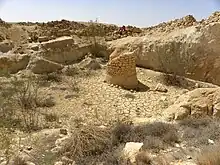
Although not as dry as at present, the area occupied by the Nabataeans was still a desert and required special techniques for agriculture. One was to contour an area of land into a shallow funnel and to plant a single fruit tree in the middle. Before the 'rainy season', which could easily consist of only one or two rain events, the area around the tree was broken up. When the rain came, all the water that collected in the funnel would flow down toward the fruit tree and sink into the ground. The ground, which was largely loess, would seal up when it got wet and retain the water.
In the mid-1950s, a research team headed by Michael Evenari set up a research station near Avdat (Evenari, Shenan and Tadmor 1971). He focused on the relevance of runoff rainwater management in explaining the mechanism of the ancient agricultural features, such as terraced wadis, channels for collecting runoff rainwater, and the enigmatic phenomenon of "Tuleilat el-Anab". Evenari showed that the runoff rainwater collection systems concentrate water from an area that is five times larger than the area in which the water actually drains.[54]
Another study was conducted by Y. Kedar in 1957, which also focused on the mechanism of the agriculture systems, but he studied soil management, and claimed that the ancient agriculture systems were intended to increase the accumulation of loess in wadis and create an infrastructure for agricultural activity. This theory has also been explored by E. Mazor, of the Weizmann Institute of Science.
Architects and stonemasons
- Apollodorus of Damascus - Greek-Nabataean architect and engineer from Damascus, Roman Syria, who flourished during the 2nd century CE. his massive architectural output gained him immense popularity during his time. He is one of the few architects whose name survives from antiquity, and is credited with introducing several Eastern innovations to the Roman Imperial style, such as making the dome a standard.[55]
- Wahb'allahi - a first century stonemason who worked in the city of Hegra.[56] Wahb'allahi was the brother of the stonemason 'Abdharetat and the father of 'Abd'obodat. He is named in an inscription as the responsible stonemason on the oldest datable grave in Hegra in the ninth year of the Nabataean king Aretas IV (1 BCE-CE).[57]
- 'Abd'obodat son of Wahballahi - a 1st-century Nabatean Stonemason who worked in the city of Hegra.[58] He is named by inscriptions on five of the grave facades typical of Hegra as the executing craftsman. On the basis of the inscriptions, four of the facades can be dated to the reigns of kings Aretas IV and Malichus II. 'Abd'obodat was evidently a successful craftsman. He succeeded his father Wahb'allahi and his uncle 'Abdharetat in at least one workshop in the second generation of Nabatean architects. 'Abd'obodat is considered to be the main representative of one of the two main schools of the Nabataean stonemasons, to which his father, his uncle belonged. Two more grave facades are assigned to the school on the basis of stylistic investigations; 'Abd'obodat is probably to be regarded as the stonemason who carried out the work.[59]
- 'Aftah - a Nabatean stonemason who became prominent in the beginning of the third decade of the first century.[60] 'Aftah is attested in inscriptions on eight of the grave facades in Hegra and one grave as the executing stonemason. The facades are dated to the late reign of King Aretas IV. On one of the facades he worked with Halaf'allahi, on another with Wahbu and Huru. A tenth facade without an inscription was attributed to the 'Aftah sculpture school due to technical and stylistic similarities. He is the main representative of one of the two stonemason schools in the city of Hegra.
- Halaf'allahi - Nabatean stonemason who worked in the city of Hegra in the first century. Halaf'allahi is named in inscriptions on two graves in Hegra as the responsible stonemason in the reign of the Nabataean king Aretas IV. The first grave, which can be dated to the year 26-27 CE, was created together with the stonemason 'Aftah. He is therefore assigned to the workshop of the 'Aftah. Nabataean architects and sculptors were in reality contractors, who negotiated the costs of specific tomb types and their decorations. Tombs were therefore executed based on the desires and financial abilities of their future owners. The activities of Halaf'allahi offer an excellent example of this, as he had been commissioned with the execution of a simple tomb for a person who apparently belonged to the lower middle class. However, he was also in charge of completing a more sophisticated tomb for one of the local military officials.[61]
Archeological sites
- Petra and Little Petra in Jordan
- Bosra in Syria
- Mada'in Saleh[62] in northwest Saudi Arabia.
- Jabal al-Lawz in northwest Saudi Arabia.
- Shivta in the Negev Desert of Israel; disputed as a Nabataean precursor to a Byzantine colony.
- Avdat in the Negev Desert of Israel
- Mamshit in the Negev Desert of Israel
- Haluza in the Negev Desert of Israel
- Dahab in South Sinai, Egypt; an excavated Nabataean trading port.
See also
References
- "Nabataeans". livius.org. Retrieved August 31, 2015.
- "Herod | Biography & Facts". Encyclopedia Britannica. 29 June 2023.
- "Solving the Enigma of Petra and the Nabataeans - Biblical Archaeology Society". Biblical Archaeology Society. 6 April 2017.
- Bowersock, Glen Warren (1994). Roman Arabia. Harvard University Press. ISBN 9780674777569.
- Catherwood, Christopher (2011). A Brief History of the Middle East. Little, Brown Book Group. ISBN 9781849018074.
- Incorporated, Facts On File (2009). Encyclopedia of the Peoples of Africa and the Middle East. Infobase Publishing. ISBN 9781438126760.
- Hornblower, Simon; Spawforth, Antony; Eidinow, Esther (2012). The Oxford Classical Dictionary. OUP Oxford. ISBN 9780199545568.
- Taylor, Jane (2001). Petra and the Lost Kingdom of the Nabataeans. London: I.B.Tauris. pp. 14, 17, 30, 31. ISBN 9781860645082. Retrieved 8 July 2016.
- Taylor, Jane (2001). Petra and the Lost Kingdom of the Nabataeans. London, United Kingdom: I.B.Tauris. pp. centerfold, 14. ISBN 978-1-86064-508-2.
The Nabataean Arabs, one of the most gifted peoples of the ancient world, are today known only for their hauntingly beautiful rock-carved capital — Petra.
- Taylor, Jane (2002). Petra and the Lost Kingdom of the Nabataeans. Harvard University Press. ISBN 978-0-674-00849-6.
- Lipiński 2000.
- Ephʿal 1984, pp. 221–223.
- "A City Carved in Stone". Petra: Lost City of Stone. Canadian Museum of Civilization. 7 April 2006. Retrieved 7 February 2011.
- Johnson, Paul (1987). A History of the Jews. London: Weidenfeld and Nicolson. ISBN 978-0-297-79091-4.
- Josephus, Flavius (1981). The Jewish War. Vol. 1. Trans. G. A. Williamson 1959. Harmondsworth, Middlesex, England: Penguin. p. 40. ISBN 978-0-14-044420-9.
- Josephus 1:61, p. 48.
- Josephus 1:363–377, pp. 75–77.
- Josephus 1:377–391, pp. 78–79.
- Smith, William Robertson (1911). . In Chisholm, Hugh (ed.). Encyclopædia Britannica. Vol. 19 (11th ed.). Cambridge University Press. pp. 146 to 147.
- Rimon, Ofra. "The Nabateans in the Negev". Hecht Museum. Archived from the original on 20 November 2018. Retrieved 7 February 2011.
- Bechtel 1908.
- Fulton 1979.
- Shahîd 1989.
- Retsö 2013, pp. 161–171.
- al-Mousawi 1998, p. 219.
- "The Dead Sea Scrolls - Browse Manuscripts". The Dead Sea Scrolls - Browse Manuscripts.
- The carbonized Petra papyri, mostly economic documents in Greek, date to the 6th century: Glen L. Peterman, "Discovery of Papyri in Petra", The Biblical Archaeologist 57 1 (March 1994), pp. 55–57.
- P. M. Bikai (1997) "The Petra Papyri", Studies in the History and Archaeology of Jordan.
- Marjo Lehtinen (December 2002) "Petra Papyri", Near Eastern Archaeology Vol.65 No.4 pp. 277–278.
- Macdonald, M. C. A. (1999). "Personal names in the Nabataean realm: a review article". Journal of Semitic Studies. XLIV (2): 251–289. doi:10.1093/jss/xliv.2.251.
- J. W. Eadie, J. P. Oleson (1986) "The Water-Supply Systems of Nabatean and Roman Ḥumayma", Bulletin of the American Schools of Oriental Research.
- J. W. Eadie, J. P. Oleson (1986) "The Water-Supply Systems of Nabatean and Roman Ḥumayma", Bulletin of the American Schools of Oriental Research.
- Nasrallah, Nawal (2007). Annals of the Caliphs' Kitchens. Brill.
- Rome and the Arabs, Dumbarton Oaks, p. 9.
- Rome in the East, Routledge, p. 65.
- Language and Identity: Arabic and Aramaic, Scripta Classica Israelica vol. XXIII 2004, p. 185.
- Arabs, Arabias and Arabic before Late Antiquity, Topoi. Orient-Occident Année 2009 16-1 p. 309.
- The Nabateans in the Early Hellenistic Period : The Testimony of Posidippus of Pella, Topoi. Orient-Occident Année 2006 14-1 pp. 48.
- John F. Healey, ‘Were the Nabataeans Arabs?’ Aram 1 (1989), 43.
- Al-Jallad, Ahmed (2015). An Outline of the Grammar of the Safaitic Inscriptions. Leiden: Brill. p. 19. ISBN 978-90-04-28929-1.
- Javier Teixidor (8 March 2015). The Pagan God: Popular Religion in the Greco-Roman Near East. Princeton University Press. p. 83. ISBN 978-1-4008-7139-1.
- Jane Taylor (2001). Petra and the Lost Kingdom of the Nabataeans. I.B.Tauris. pp. 124–151. ISBN 978-1-86064-508-2.
- Francisco del Río Sánchez (4 December 2015). Nabatu. The Nabataeans through their inscriptions. Edicions Universitat Barcelona. p. 118. ISBN 978-84-475-3748-8.
- Rough Guides (1 November 2016). The Rough Guide to Jordan. Apa Publications. p. 395. ISBN 978-0-241-29849-7.
- Mahdi al-Zoubi: Nabataean Practices for Tombs Protection - p. 3.
- Healey, John F. “Images and Rituals.” The Religion of the Nabataeans: A Conspectus. Boston: Brill, 2001. 169–175. Print.
- "Biblical Archaeology Review, May/June 2016, page 20". Archived from the original on 2018-04-05. Retrieved 2016-05-27.
- John F. Healey (1990). The Early Alphabet. University of California Press. p. 52. ISBN 978-0-520-07309-8.
- Tony Maalouf. Arabs in the Shadow of Israel: The Unfolding of God's Prophetic Plan for Ishmael's Line. Kregel Academic. p. 172. ISBN 978-0-8254-9363-8.
- Nabataean to Arabic: Calligraphy and script development among the pre-Islamic Arabs by John F. Healey p. 44.
- Arabic in Context: Celebrating 400 years of Arabic at Leiden University. BRILL. 21 June 2017. p. 79. ISBN 978-90-04-34304-7.
- Roger D. Woodard (10 April 2008). The Ancient Languages of Syria-Palestine and Arabia. Cambridge University Press. p. 2. ISBN 978-1-139-46934-0.
- Brinkman, Gelb, Civil, Oppenheim & Reiner (1980). The Assyrian Dictionary (PDF). Oriental Institute, Chicago. p. 22. ISBN 978-0-918986-17-7.
{{cite book}}: CS1 maint: multiple names: authors list (link) - Johnson, Douglas L.; Lewis, Laurence A. (2007). Land Degradation: Creation and Destruction. Rowman & Littlefield. ISBN 978-0-7425-1948-0.
- Landart, Paula (2015). Finding Ancient Rome: Walks in the city.
- Keller, Daniel (2007). Rainer Vollkommer (Hrsg.): Künstlerlexikon der Antike . Over 3800 artists from three millennia. Nikol, Hamburg 2007. Nikol. p. 947. ISBN 978-3-937872-53-7.
- Healey, John (1994). "The Nabataean Tomb Inscriptions of Mada'in Salih". Journal of Semitic Studies Supplement. 1 (Oxford University Press): 154–162.
- Zbigniew, Fiema (1987). "Remarks on the Sculptors from Ḥegra". Journal of Near Eastern Studies. 46 (1): 52–53.
- Keller, Daniel (2007). Abd'obodat. In: Rainer Vollkommer (Herausgeber): Künstlerlexikon der Antike. Über 3800 Künstler aus drei Jahrtausenden. Nikol. ISBN 978-3-937872-53-7.
- Keller, Daniel (2007). Aftah. In: Rainer Vollkommer (editor): Künstlerlexikon der Antike. Over 3800 artists from three millennia. Nikol. p. 6. ISBN 978-3-937872-53-7.
- Negev, Abraham. Nabatean Necropolis. p. 219.
- "Nabataea: Medain Saleh". nabataea.net.
Sources
- Ephʿal, Israel (1984). The Ancient Arabs: Nomads on the Borders of the Fertile Crescent, 9th-5th Centuries B.C. Jerusalem: Magnes Press, Hebrew University. ISBN 978-0-685-74243-3.
- Graf, David F. (1997). Rome and the Arabian Frontier: From the Nabataeans to the Saracens. Aldershot: Ashgate. ISBN 978-0-86078-658-0.
- Healey, John F., The Religion of the Nabataeans: A Conspectus (Leiden, Brill, 2001) (Religions in the Graeco-Roman World, 136).
- Krasnov, Boris R.; Mazor, Emanuel (2001). The Makhteshim Country: A Laboratory of Nature: Geological and Ecological Studies in the Desert Region of Israel. Sofia: Pensoft. ISBN 978-954-642-135-7.
- Lipiński, Edward (2000). The Aramaeans: Their Ancient History, Culture, Religion. Orientalia Lovaniensia analecta. Vol. 100. Leuven, Belgium: Peeters Publishers. pp. 448–450. ISBN 9789042908598.
- "Nabat", Encyclopedia of Islam, Volume VII.
- Negev, Avraham (1986). Nabatean Archaeology Today. Hagop Kevorkian Series on Near Eastern Art and Civilization. New York: New York University Press. ISBN 978-0-8147-5760-4.
- Schmid, Stephan G. (2001). "The Nabataeans: Travellers between Lifestyles". In MacDonald, Burton; Adams, Russell; Bienkowski, Piotr (eds.). The Archaeology of Jordan. Sheffield, England: Sheffield Academic Press. pp. 367–426. ISBN 978-1-84127-136-1.
External links
- Hecht Museum - Catalogues | The Nabateans in the Negev
- Hecht Museum - Exhibitions | The Nabateans in the Negev
- The Bulletin of Nabataean Studies online—links on Petra and the Nabataeans
- NABATÆANS in the Jewish Encyclopedia
- Cincinnati Art Museum—the only collection of ancient Nabataean art outside of Jordan
- Archaeological Studies—Ancient Desert Agriculture Systems Revived (ADASR)
- Petra: Lost City of Stone Exhibition—Canadian Museum of Civilization
- "Solving the Enigma of Petra and the Nabataeans", Biblical Archaeology Review
- Nabataeans a nation civilization—Petra Crown
- Quellen zur Geschichte der Nabatäer—Ursula Hackl, Hanna Jenni, and Christoph Schneider
